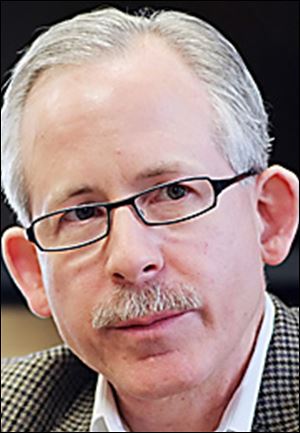
UT subsidiary working on photograph-based device to test blood glucose levels
1/28/2013
Brent Cameron, an associate professor of bioengineering at the University of Toledo and inventor of a device being developed to measure blood glucose levels by photographing the iris.
A company owned by a subsidiary of the University of Toledo is developing a technology that could be used to measure blood glucose levels by taking a picture of the iris.
IRISense LLC, which is owned by University of Toledo Innovation Enterprises, is planning to eventually transform the technology into a smart-phone application, said Brent Cameron, a UT associate professor who created the technology that is now limited to a desktop device similar to something seen in an eye doctor’s office.
Human testing for the technology is expected to begin next next month, Mr. Cameron said.
“Basically what we are doing is imaging the iris,” he said. “The technology we started looking into in 2007 was a skin-based system that transformed into this.”
IRISense is among a list of start-up companies operating out of UT or with funding from UTIE — the economic development arm of the university that was reseeded in 2008 with $10 million to invest in companies such as IRISense.
UTIE hasn’t invested any money in the company yet. “UTIE has committed $125,000 to develop out the business side of the company,” said Rick Stansley, Jr., who manages UTIE as a contract employee paid by the university.
“This could be a home run,” he said. “The payback could be in the seven figures ... This one is really exciting because it started at UT and it is still at UT.”
Other companies in UTIE’s portfolio include solar panel maker Xunlight, other technology firms, and pharmaceutical companies.
“We are writing down investments in a number of different things right now, mostly in the pharmaceutics area, where we probably shouldn’t have been with to begin with," Mr. Stansley said. "We wanted to do pharmaceutics because your big hits are there ... but we don't have the resources ... so we have shifted our focus."
Brent Cousino, interim chief executive of IRISense, said a 16-megapixel camera would be needed for the technology to work on smart phones. Most smart phones come equipped with an eight-megapixel camera.
Future generations of smart phones will routinely have that level of cameras, he said.
“There will be a point this calendar year when IRISense will need more investment once we get through the human studies,” Mr. Cousino said. “I am willing to volunteer myself.”
Animal trials were conducted on rabbits, he said.
Stephen Snider, UT’s associate vice president, technology transfer, and associate general counsel, said the technology eventually could be used to detect blood-alcohol levels and even stress by measuring lactic acid levels.
Rocket Ventures LLC, of which Mr. Stansley is the board chairman, invested $20,000 in IRISense and the university has invested $70,000. Some of that money was spent developing the desktop prototype. IRISense applied for but was denied $100,000 from the Ohio Third Frontier Technology Validation and Start-Up Fund. Six companies asked for the money and four were denied.